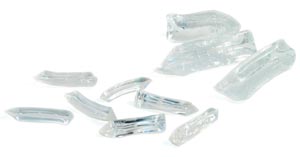Objectives:
1. Students will brainstorm factors that might affect an animal living on the seashore at high and low tides.
2. Students will identify strategies that shore animals use to survive conditions at low tide.
3. Students will design an experiment to test whether the strategy adopted by their simulated shore animal would be effective in helping it survive low tide.
Focus Question:
How do marine animals survive low tide?
Background:
The seashore is an inhospitable place for marine animals to live. Seawater has much less temperature variation throughout the year than air. In other words, during the summer in New York it can be 98˚F but the sea isn’t much warmer than 75˚F. In the depths of winter it can be –10˚F on land, but the water will be 48˚F. Animals that spend all their lives out at sea have a fairly steady environment. Those that are exposed to air at low tide, may face broiling hot temperatures in summer and freezing cold temperatures in winter. They may be soaked in fresh water when it pours with rain, and pounded by rough waves during a storm. Animals that can survive on the shore have to be tough! The higher the animals live up the shore, the longer they are likely to be exposed to the land environmental conditions. On rocky shores this leads to bands of animals that are the best adapted to being exposed for that period of time. These bands are called tidal zones.
Strategies that organisms have adopted include:
- burrowing into the sand (crabs)
- being covered with thick slime (seaweed and sea-squirts)
- moving with the falling tide (snails)
- clamping down onto a rock (limpet)
- shutting their shells tight (mussels and barnacles).
All these adaptations will reduce evaporation and avoid desiccation.
Teacher Preparation:
 Soak 30 water gel spikes or large gel growing spheres (from Educational Innovations) in cold water before the lesson. Read the background information for this lesson. If at all possible borrow some triple beam balances, and have students weigh their worms/creatures at the start and at the end of the experiment.
Soak 30 water gel spikes or large gel growing spheres (from Educational Innovations) in cold water before the lesson. Read the background information for this lesson. If at all possible borrow some triple beam balances, and have students weigh their worms/creatures at the start and at the end of the experiment.
Materials:
Possible Materials For The Class:
- Overheads of various rocky and sandy shore animals.
- A selection of materials that student could use to help protect their animal at low tide these could include:
- Petri dishes (limpet shell)
- Small medicine cup (top shell)
- Vaseline or Nickleodean slime (thick slime coat), put in spoon and then apply with q -tip
- Wrapping in a damp paper towel (burrowing in wet sand),
- Water in a dish (following the tide),
- Real clam shells
- Wet sand or anything else realistic
- Saran Wrap/waxed paper
- Anything else that you feel is reasonable and appropriate
For each of student:
- 1 water gel spike/gel sphere
- A selection of materials (see above)
- Journal page
- Pen/pencil
Time: 60 minutes
Anticipatory Set:
Suppose you are a little marine organism sitting on the beach at low tide. What would conditions be like on a hot summer day? What would conditions be like on a winter day? How could you survive?
Student Activity:
1. Have students brainstorm very briefly what seashore animals do at low tide. You might show them pictures to help them.
2. Give each student their “organism”. Explain that it would be cruel to use real animals, and so “No animals will be harmed during this experiment!” they are going to use water gel spikes or spheres to stand in for the organism.
3. Their task is to come up with a strategy for their animal to survive low tide (on the windowsill) overnight. They can use any of the materials available in the classroom. Remind them that scientists quantify their data because that is a way to statistically prove their conclusions – measurement with rulers, balances, etc is encouraged.
4. Students brainstorm what they can do to help their animal survive, pair and share and then complete the first portion of the journal page. They might choose to base their design on solutions that real seashore animals use. (This approach is called biomimicry, and is one of the hottest topics in bioengineering today.) You will have some water gel spikes and spheres left over. These poor “animals” will act as the controls for this experiment. They will be left on the windowsill with no protection or strategy with which to prevent desiccation.
5. The next day students observe their animal and see if the strategy they designed enabled their animal to avoid desiccation and survive. Students complete the journal page.
Key Vocabulary:
Organism – a living thing.
Desiccate – to dry out or lose water.
Tidal Zone – how high or low an organism lives on the shore. This will determine how long it is uncovered by the tide.
Resources:
- Diagram of tidal zones
- Pictures of shore animals.
Enrichment:
Have students weigh their “worms” or organisms at the start and end of the experiment. What percentage of weight was lost? If their worm loses more than 20% of its weight, it will die.

get some info on HOW the tides AFFECT the animals example:
how it affects their homes
how it affects their life
how it affects their life expectancy
how it affects their food supply ect….